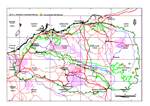Click on images
to enlarge



Photographer: B.R. Maslin

Photographer: B.R. Maslin

Photographer: B.R. Maslin

Photographer: B.R. Maslin

Photographer: B.R. Maslin

Immature pods. Photographer: B.R. Maslin

Photographer: B.R. Maslin
, BRM 8855, lab photo by Fiona McCallum ADJUSTED_sml.jpg)
Seed from one herbarium voucher. Scale in mm. Photographer: F. McCallum.
Botanical name
Acacia balsamea Cowan & Maslin, Nuytsia 12: 417 (1999)
Common name
Balsam Wattle
Description
Multi-stemmed, spreading, rounded or obconic shrubs 1-4 m high, rarely a single-stemmed tree 4 m tall with stems to 14 cm in diameter at breast height, main stems straight or sometimes slightly crooked and much-branched, crown foliage sparse to dense and concentrated towards the ends of the branches. Bark grey, finely longitudinally fissured toward base of old stems, otherwise smooth. Branchlets reddish brown and resin-ribbed at extremities, with minute, silvery, appressed, straight hairs between the ribs (hairs very sparse or absent on mature branchlets). Phyllodes terete to ± flat, 8-13 cm long, 0.8-1.4 mm wide (rarely to 3 mm wide outside the Pilbara), not rigid, erect, straight to shallowly curved or sometimes shallowly sinuous, fresh phyllodes emit either an aromatic or unpleasant odour when crushed, green or light greyish green when fresh but drying khaki green; with numerous, fine, resinous, longitudinal nerves, few appressed hairs between nerves (superficially appearing glabrous: observe at x10 magnification or higher); apex curved to somewhat hooked, hard but not spiny. Inflorescences simple, 1 or 2 within axil of phyllodes; peduncles 4-10 mm long, glabrous or with minute, silvery, appressed straight hairs; heads sub-globular to obloid, 5-8 mm long when dry, 20-30-flowered. Flowers 5-merous; sepals free or almost so. Pods pendulous, sub-moniliform, terete to sub-terete (somewhat flattened when immature), straight-edged to shallowly constricted between the seeds, 5-13 cm long, 2-4 mm wide, coriaceous-crustaceous to sub-woody, straight to shallowly curved, longitudinally striate by shiny, resinous nerves (but not sticky), with minute, silvery, appressed, straight hairs between the nerves. Seeds longitudinal in the pods, narrowly obloid, 4-5 mm long, about 1.5 mm wide, glossy, very dark brown to black; aril white and conspicuous.
Characteristic features
Phyllodes long and narrow (8-13 cm x 0.8-1.4 mm), terete to almost flat, not rigid, drying khaki green, with aromatic or unpleasant odour when crushed, finely multistriate, the tips curved to somewhat hooked. Heads sub-globular to obloid. Pods long and narrow (5-13 cm x 2-4 mm), terete to sub-terete, coriaceous to sub-woody, strongly longitudinally nerved.
Distribution and ecology
Widely scattered in arid central Western Australia where it extends from eastern extremity of the Pilbara region east to the Rudall River National Park, south to Leinster (north of Kalgoorlie) and east to the Clutterbuck Hills in the Gibson Desert. In the Pilbara A. balsamea is found in a restrict area in the east of the region where it has been recorded from Mt Divide, Noreena Downs and Balfour Downs stations. Here it grows on silcrete plains and hardpans and in stony reddish brown sandy loam on low hills, often associated with shallow watercourses. Although poorly collected, A. balsamea is common in the places where it occurs.
Flowering and fruiting period
The paucity of collections makes it difficult to accurately determine the phenology of this species. In the Pilbara region at least A. balsamea appears to flower in response to the timing, and probably also the intensity, of rainfall. Pilbara specimens have been collected in July and August at which time the plants were either just starting to flower or were with near-mature pods (seeds about one month short of maturity); the pods were sometimes accompanied by a few young flower buds. Judging from this, and from specimens collected at the Rudall River, it appears that at least one flowering flush occurs between late July and September. It is not known whether the pods that are present on the plants during part of this period are the result of a flowering event that occurred earlier in the year or from the July-September flowering of the previous year.
Variation
Outside the Pilbara region (in Gibson Desert) the phyllodes are sometimes distinctly flattened (reaching 3 mm wide). Within the Pilbara, however, the phyllodes that are terete to somewhat flattened and are not above 1.4 mm wide. There is also variation with respect to phyllode smell. On plants from around Leinster (north of Kalgoorlie) the fresh, crushed phyllodes emit a mild, sweet aromatic odour (not dissimilar to that of Friars Balsam) and it was this characteristic that gave rise to the species name; this smell is less obvious on dry specimens. However, the fresh phyllodes of Pilbara plants emit a rather unpleasant odour when crushed. The reasons for this variation, and its taxonomic significance, if any, remains unknown.
Affinities
The precise affinities of this species are unknown; however, it has the general appearance of A. aneura (Mulga) but is distinguished by having no reddish resin hairlets on its new shoots, sub-globular to obloid heads and strongly nerved, long, narrow, sub-moniliform pods.
Notes
Plants killed by fire; regeneration from seed.
Conservation status
Not considered rare or endangered.
Origin of name
The botanical name is derived from balsameus, an adjectival form of a Latin word for a fragrant gum and refers to the odour emitted by the crushed, fresh phyllodes of some plants, which is reminiscent of the Northern Hemisphere Balsam Fir ('Friars Balsam'). See notes under Variation above.
